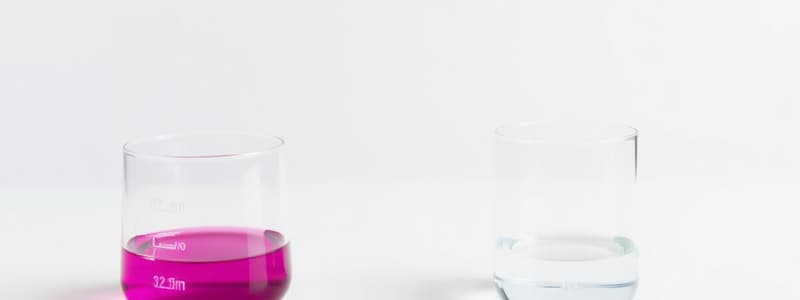Podcast
Questions and Answers
What is the concentration of H+ ions in pure water?
What is the concentration of H+ ions in pure water?
- 10-9 mole
- 10-8 mole
- 10-7 mole (correct)
- 10-6 mole
What does a larger K₂ value indicate about an acid?
What does a larger K₂ value indicate about an acid?
- Weaker acid
- Stronger base
- Neutral strength
- Stronger acid (correct)
If the pH of a solution is less than 7, what can be inferred about the solution?
If the pH of a solution is less than 7, what can be inferred about the solution?
- It is acidic (correct)
- It is neutral
- It is alkaline
- It has a higher concentration of OH- ions
How is the relationship between pKa and acid strength characterized?
How is the relationship between pKa and acid strength characterized?
What is the formula to calculate pOH from pH?
What is the formula to calculate pOH from pH?
When the concentration of H+ ions is greater than 10-7, how is the solution classified?
When the concentration of H+ ions is greater than 10-7, how is the solution classified?
What does an increase in Ka imply about an acid?
What does an increase in Ka imply about an acid?
Which statement is true about pH and pKa?
Which statement is true about pH and pKa?
Which substances are classified as non-electrolytes?
Which substances are classified as non-electrolytes?
For a strong electrolyte, the degree of dissociation (α) is approximately equal to which value?
For a strong electrolyte, the degree of dissociation (α) is approximately equal to which value?
What does the degree of dissociation (α) indicate?
What does the degree of dissociation (α) indicate?
What is the dissociation equation for hydrochloric acid (HCl) in water?
What is the dissociation equation for hydrochloric acid (HCl) in water?
According to the law of mass action, which equation defines the equilibrium constant (K)?
According to the law of mass action, which equation defines the equilibrium constant (K)?
Which of the following statements is true regarding the dissociation of water?
Which of the following statements is true regarding the dissociation of water?
What does the symbol K represent in the context of chemical reactions?
What does the symbol K represent in the context of chemical reactions?
If the degree of dissociation (α) is 60%, what does this imply?
If the degree of dissociation (α) is 60%, what does this imply?
What is the pH of a completely ionized 1.0 N solution of hydrochloric acid?
What is the pH of a completely ionized 1.0 N solution of hydrochloric acid?
For a solution of 0.009 N hydrochloric acid, what is the pH?
For a solution of 0.009 N hydrochloric acid, what is the pH?
How is the pH of a weak acid, like acetic acid, calculated?
How is the pH of a weak acid, like acetic acid, calculated?
What would be the pH of a 0.0045 M solution of phenobarbital with a pK of 7.41?
What would be the pH of a 0.0045 M solution of phenobarbital with a pK of 7.41?
Calculate the pH of a 0.13 N ammonia solution with a pK of 4.76.
Calculate the pH of a 0.13 N ammonia solution with a pK of 4.76.
What is the hydroxyl ion concentration of a solution with a pH of 10.75?
What is the hydroxyl ion concentration of a solution with a pH of 10.75?
If the pH of a solution is 5.3, what is the hydrogen ion concentration?
If the pH of a solution is 5.3, what is the hydrogen ion concentration?
A salt formed from a strong acid and a strong base typically has what pH?
A salt formed from a strong acid and a strong base typically has what pH?
What is hydrolysis in the context of salts?
What is hydrolysis in the context of salts?
Which condition results in a salt solution having a pH less than 7?
Which condition results in a salt solution having a pH less than 7?
In the context of ammonia chloride (NH4Cl), which statement is correct regarding its hydrolysis?
In the context of ammonia chloride (NH4Cl), which statement is correct regarding its hydrolysis?
What determines the pH level of a salt solution?
What determines the pH level of a salt solution?
How do you calculate the percentage of salt hydrolyzed in solution?
How do you calculate the percentage of salt hydrolyzed in solution?
Given a 0.1 M sodium acetate solution with a pK of 4.76, what is the calculated pH?
Given a 0.1 M sodium acetate solution with a pK of 4.76, what is the calculated pH?
In the context of salts, what is the degree of hydrolysis?
In the context of salts, what is the degree of hydrolysis?
What is the expected pH for a salt formed from a weak acid and a weak base?
What is the expected pH for a salt formed from a weak acid and a weak base?
Flashcards are hidden until you start studying
Study Notes
Arrhenius Theory of Ionization/Dissociation
- Electrolytes dissociate into oppositely charged ions when dissolved in water.
- Non-electrolytes do not ionize at all in solution.
- Degree of Dissociation (α): The fraction of molecules that dissociate into ions; expressed as a percentage.
- α = (number of molecules dissociated / total number of molecules) x 100%
- Strong Electrolytes (Strong acids and bases) have α close to 1.
- Weak Electrolytes (Weak acids and bases) have α less than 1.
Law of Mass Action
- The rate of a chemical reaction is proportional to the active masses of the reacting substances.
- Equilibrium Constant (K): Ratio of product concentrations to reactant concentrations at equilibrium.
- K = [C][D] / [A][B]
- Dissociation of Water:
- Water is a weak electrolyte, H₂O ↔ H+ + OH-
- Ionic Product of Water (Kw): [H+][OH-] = 10⁻¹⁴
- pH Scale:
- pH = -log[H⁺], pOH = -log[OH⁻]
- pKw = pH + pOH = 14
- Neutral:[H+] = [OH-] = 10⁻⁷
- Acidic: [H+] > 10⁻⁷
- Alkaline (Basic): [H+] < 10⁻⁷
Dissociation of Acids and Bases
- Weak Acids: HA + HOH <=> H3O+ + A-
- Ka: Acid ionization constant, K = [H+][A-] / [HA]
- Weak Bases: B + HOH <=> BH+ + OH-
- Kb: Base ionization constant, K = [BH+][OH-] / [B]
- pKa and pKb: Relate to the strength of acids and bases:
- pKa = -logKa, pKb = -logKb
- Larger Ka (smaller pKa) = Stronger acid
- Larger Kb (smaller pKb) = Stronger base
Importance of Dissociation Constants
- Ka and Kb values determine the strength of acids and bases.
- pH Calculations:
- Strong Acid: pH = -log [H+], pH = pC₂ (concentration of acid)
- Strong Base: pH = pKw - pCb (concentration of base)
- Weak Acid: pH = ½ (pKa + pCa)
- Weak Base: pH = pKw - ½ (pKb + pCb)
- Salts:
- Neutral Salt: Formed by the reaction of a strong acid and a strong base, pH = 7.
- Basic Salt: Formed by the reaction of a weak acid and a strong base, pH > 7.
- Acidic Salt: Formed by the reaction of a strong acid and a weak base, pH < 7.
- Salt of Weak Acid & Weak Base: pH = 0.5 (pKa + pKb - pCs)
- Degree of Hydrolysis (h): The fraction of salt hydrolyzed at equilibrium.
- h = (concentration of hydrolyzed species) / (concentration of salt)
- % hydrolysis = 100 x h
- Remember:*
- pKa gives information about the acid's dissociation in water; pH gives information about the H+ concentration in solution.
- The stronger the acid or base, the higher the Ka or Kb values, and the lower the pKa or pKb values.
- The pH of a salt solution depends on the strengths of the original acid and base that formed it.
Studying That Suits You
Use AI to generate personalized quizzes and flashcards to suit your learning preferences.




